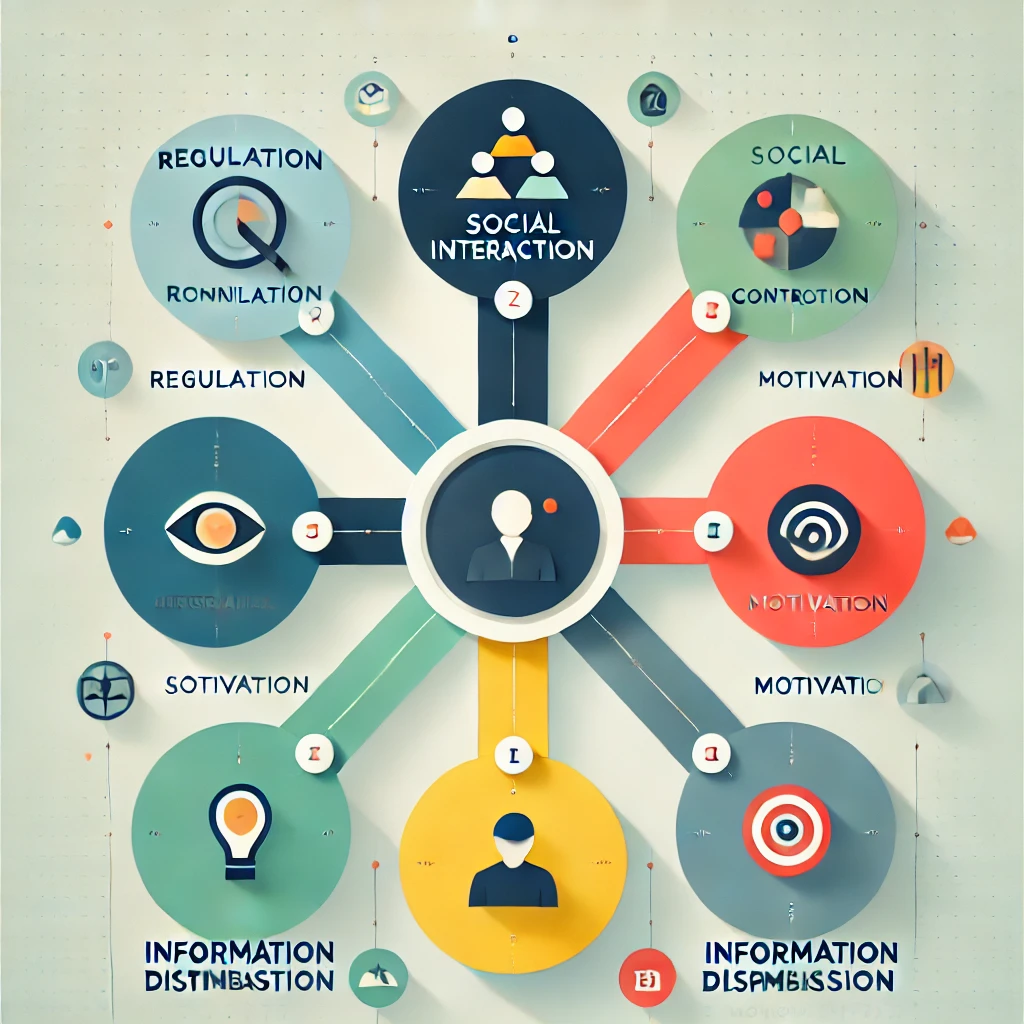by Venchito Tampon | Last Updated on October 31, 2024
Communication serves various important roles in everyday life, shaping human behavior, relationships, and professional careers. In the context of the Philippines, we can categorize communication into five functions: Control/Regulation, Social Interaction, Motivation, Emotional Expression, and Information Dissemination.
Here’s a concise breakdown of each function and examples I’ve seen as a corporate trainer and resource speaker.
Contents
Toggle1. Control/Regulation: Managing Behavior and Social Norms
Communication as a tool for control or regulation ensures that people’s behaviors are aligned with rules, specific laws, and norms, whether in formal settings like the workplace or informal ones like family and social gatherings.
Controlling communication shouldn’t be viewed as negative but rather as a pathway to managing certain behaviors that aren’t aligned with either individual or organizational goals.
One good example of using communication for control or regulation in the Philippines is frequently seen in public advisories and government regulations. For instance, during natural disasters like typhoons, the government issues warnings and evacuation orders through mass communication channels, ensuring public safety.
At home, elders use verbal and nonverbal communication to guide younger family members and instill values such as respect and obedience. Using “opo” in conversing with elders is one way to show respect and submission to them.
Business communication also helps establish rules, guidelines, and policies to maintain discipline and productivity. Training managers on communication during regular meetings, memos, and employee handbooks help ensure that everyone in the organization understands expectations and complies with standards.
Another way to use communication for control is through performance management. Managers, supervisors, and directors can check and monitor the performance of their direct reports and control it by recommending solutions or through coaching—asking questions to assist their team members with options and solutions.
At Rainmakers, we conduct various managerial and leadership training programs that focus on communication, team management, problem-solving, and decision-making.
2. Social Interaction: Building and Maintaining Relationships
The social interaction function fosters connections and relationships vital in personal and professional contexts. Effective communication enables individuals to establish rapport, share experiences, and maintain social ties.
In the Philippines, where family and community bonds are central, social interaction is deeply embedded in day-to-day communication. Fiestas, weddings, and other gatherings are typical venues for social interaction, where communication strengthens relationships. The value of “pakikisama” (getting along well with others) is practiced in workplaces and among friends, where open communication helps foster cooperation and teamwork.
The context of social interaction for Filipinos is also visible in the workplace. You’ve seen more traffic on the streets on Fridays, as Filipino workers used to spend more time with their colleagues (i.e., “Friday nights”).
Moreover, with the vast diaspora of Filipinos working abroad, social media platforms like Facebook are crucial for maintaining connections between OFWs and their families. This digital form of social interaction keeps relationships alive despite geographic distances.
Today, we have different digital platforms to communicate with our loved ones anywhere and anytime.
3. Motivation: Inspiring Action and Change
Motivational communication drives people to take action, achieve goals, or change behavior. This function is prominent in leadership, education, and marketing.
Politicians, religious leaders, and motivational speakers use communication to inspire action in the Philippines. Political campaigns, for example, rely heavily on persuasive speeches and advertisements to motivate voters to participate in elections. Similarly, teachers encourage students to work hard and pursue their dreams, often with words of encouragement that inspire effort and determination.
Businesses also use motivational communication to drive performance. Sales targets, performance incentives, and corporate goals are communicated effectively to inspire teams to meet objectives and exceed expectations.
Filipino leaders frequently appeal to the heart—“puso”—as part of their motivational strategy. In fact, we adhere to and respect leaders who are more humane than others (pagiging ‘Makawao’), as we want someone who can understand and empathize with our needs and challenges.
In our leadership training for managers and supervisors, we go deep into the root meaning of motivation – “movere”, which comes from both “move” and “motives.”
4. Emotional Expression: Sharing and Managing Emotions
Communication allows individuals to express their emotions and form deeper emotional connections with others. This function is essential in building empathy and understanding.
In Filipino culture, emotional expression is highly valued in personal relationships. The expression of “kilig” (romantic excitement), “hiya” (modesty), or “lambing” (affection) is common in both verbal and non-verbal communication. Whether through heartfelt conversations or simple gestures, communication serves as a medium for emotional expression.
Emotional communication is also essential in mental health advocacy, which has gained more attention in the Philippines. Encouraging open dialogue about emotions has become a key part of destigmatizing mental health concerns, providing individuals with a safe space to express their feelings.
Developing someone’s emotional intelligence is also crucial in the workplace, as leaders must know how to be sensitive to other people’s feelings. They can also enhance their inspirational skills further to push their direct reports to perform better and integrate their professional lives, which further translates to a healthy culture.
5. Information Dissemination: Sharing Knowledge and Facts
Information dissemination is critical for education, public awareness, and decision-making. Communication ensures that knowledge is effectively spread to large groups of people.
In the Philippines, the media—television, radio, and online platforms—plays a vital role in information dissemination. News programs, public service announcements, and government briefings provide essential information on health advisories, education programs, and national events.
For example, media outlets inform the public about candidates, platforms, and voting procedures during election periods.
Educational institutions are also key players in information dissemination. Teachers and trainers pass on knowledge and skills through structured communication, ensuring that students and employees acquire the information they need for personal and professional development.
I’ve seen government agencies actively searching for corporate training providers who can conduct proper digital public relations and communication training for their staff, particularly the ones handling their social media campaigns and offline public relations. These people must be equipped with the right tools to disseminate information with credibility and authenticity.
Conclusion
The five functions of communication—control/Regulation, Social Interaction, Motivation, Emotional Expression, and Information Dissemination—are essential in shaping behavior, building relationships, inspiring action, expressing emotions, and spreading knowledge.
In the Philippines, these functions are deeply ingrained in cultural practices and everyday life, reflecting the importance of effective communication in maintaining social harmony and progress. Understanding and applying these functions can enhance personal, professional, and societal communication, leading to better outcomes across various contexts.
The Author
Venchito Tampon
Venchito Tampon is a Filipino motivational speaker, Business Consultant, Founder and Lead Corporate Trainer of Rainmakers Training Consultancy. He trained and spoken in over 250+ conventions, seminars, and workshops across the Philippines and internationally including Singapore, Slovakia, and Australia. He has worked with top corporations including SM Hypermarket, Shell, and National Bookstore.
He also founded SharpRocket, a digital marketing company, Blend N Sips, eCommerce for coffee supplies, and Hills & Valleys Cafe, a local cafe with available franchising.
He is a certified member of The Philippine Society for Talent Development (PSTD), the premier organization for Talent Development practitioners in the country.
An active Go Negosyo Mentor (of Mentor Me program) and a business strategist and consultant.
You may also like
Training Matrix: A Complete Guide
Training mix is a structured framework that helps HR and Learning and…
Learning and Development Plan: A Complete Guide
Learning and Development Plan (L&D plan) is a structured flow and framework…




